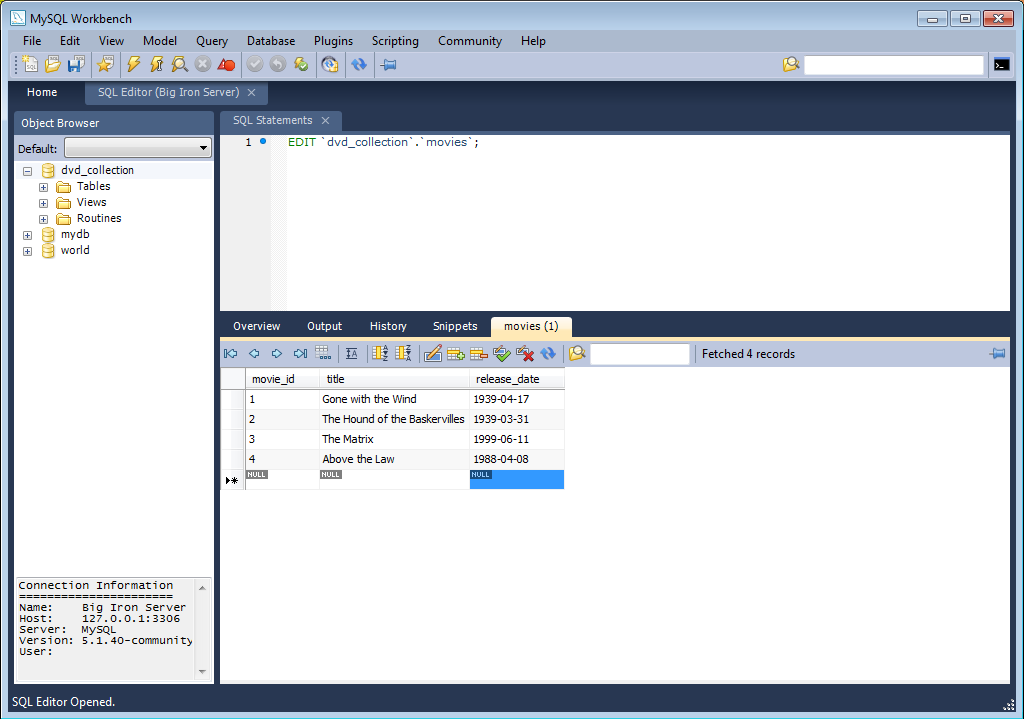
- #Add sql file to mysql database workbench how to#
- #Add sql file to mysql database workbench update#
- #Add sql file to mysql database workbench driver#
- #Add sql file to mysql database workbench code#
Log in to the ColdFusion Administrator (usually located at /cfide/administrator/) using your username and password.Ĭlick Data Sources in the left menu (under DATA & SERVICES). Here are the steps for configuring a data source in ColdFusion: Once you've set up the data source, it can be used on any ColdFusion page on that ColdFusion server.
#Add sql file to mysql database workbench code#
Here, you create a "data source" connection which you can refer to within your code (as we did in the above example). This provides the connection to the database.ĬoldFusion allows you to connect to a database via its administration interface (ColdFusion Administrator). The above code assumes that a data source connection called dsnFruitShop has been previously set up. Here's what the above query turned out like once converted to PHP Open your PHP document and paste the code. The code will be pasted to your clipboard. Select Tools | Utilities | Copy as PHP Code (Iterate SELECT Results) Run the query that you will be using from the website. It also generates the PHP code to iterate through the result set (so that the results can be displayed to the website user).Īgain, clicking on this option copies the code to your clipboard. This option allows you to generate PHP code that embeds the SQL statement into a PHP script. Copy as PHP Code (Iterate SELECT Results) The code also provides an error message in case the connection fails.
#Add sql file to mysql database workbench driver#
This code uses the MySQLi driver, which driver is used by PHP to provide an interface with MySQL databases.
#Add sql file to mysql database workbench update#
Simply paste this code into the PHP document that needs to connect to MySQL and update any fields as required. Or die ('Could not connect to the database server'. $con = new mysqli($host, $user, $password, $dbname, $port, $socket) Here's an example of the code that this option produces: You can always replace the parameters with another connection if required.Ĭlicking on this option simply copies the code to your clipboard. This option generates PHP code that connects using the parameters for the connection that you're currently using. You can access it from the Tools | Utilities menu: Copy as PHP Code (Connect to Server) Well, it's not a full-blown PHP generator, but it will generate enough PHP code for you to paste into your website so that it can connect to MySQL and run your queries. MySQL Workbench includes a PHP generator. The server-side script would first connect to MySQL, then it can run any query that it needs to. But of course, I'm sure you don't have a little gremlin sitting inside your website just waiting around for an SQL query to type every time someone visits your website? After all, you'd need to find a gremline with a good knowledge of SQL - not easy to find these days!Ī better solution would be to do what most other websites do - use a server-side programming language to interface between the website and the MySQL server. Querying a MySQL database from your website is not much different to querying it from MySQL Workbench - you use the same SQL statements for both.
#Add sql file to mysql database workbench how to#
It's all very well using MySQL Workbench for all our examples, but you might be wondering how to create a website with MySQL? After all, MySQL is used by more websites than any other database management system. You can tell which database is the default one because it is bolded.Here's how to connect a website to a MySQL database. Simply right click on the database name and select Set as Default Schema: Setting the database as the Default Schema.īy doing this, any scripts that don’t specify a database will run against this one. You can set the new database as the default schema if you wish. Setting the Database as the Default Schema You will need to add tables and other database objects before you can add data. You will now be able to see the database under SCHEMAS in the left navigation pane. The following message will be displayed if the script has run successfully: The “Success” message when the script has run successfully. Review the SQL statement and click Apply: This screen allows you to review the script generated by MySQL before applying it. Enter the schema name (database name) and its default collation.


Enter a Name & Default CollationĮnter a schema name (database name) and its default collation and click Apply: The “New Schema” dialog. The New Schema ButtonĬlick the “new schema” button on the MySQL Workbench toolbar: The “Create Schema” button on the MySQL Workbench toolbar. The database will now be created, and a message will display advising that the script was successful.īelow are screenshots for the above steps.

To create a database in the MySQL Workbench GUI:


 0 kommentar(er)
0 kommentar(er)
